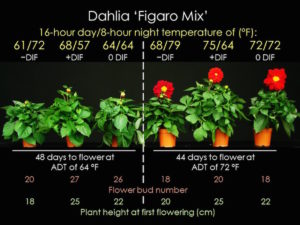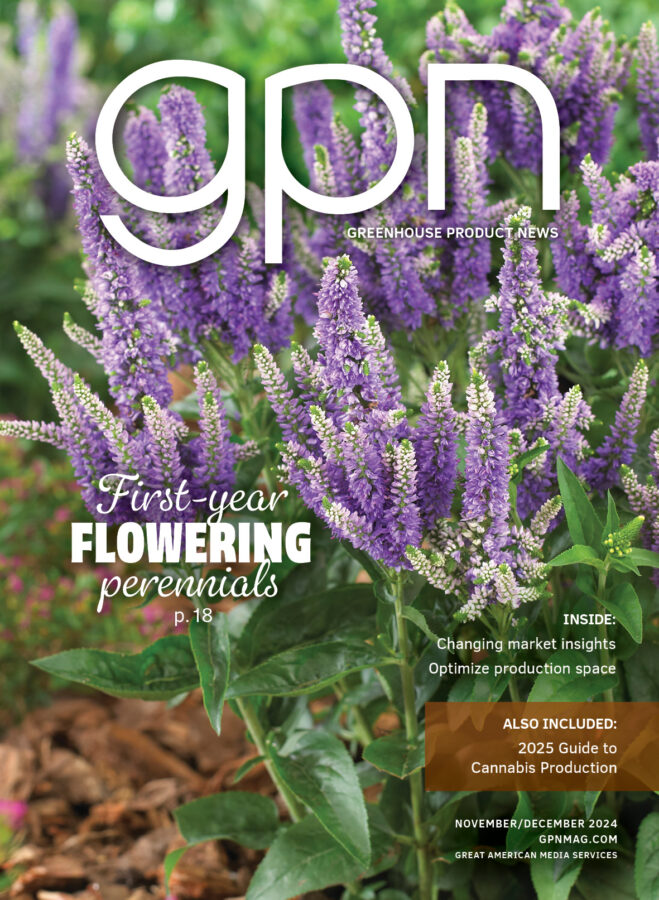Temperature Integration
Plant development is primarily a function of temperature; crops develop progressively faster as temperature increases, until some high temperature at which they grow as fast as possible. Some sources of information give crop production times based only on recommended night temperatures. However, those guidelines are of limited use because the average of the day and night temperature is what controls the rate of plant development. In other words, plants integrate temperature very well and production time is based on the average temperature over an extended period.
To illustrate temperature integration on a daily basis, we performed an experiment with several bedding plant crops in which plants were grown at two average daily temperatures of 64 or 72° F. For each of these two averages, there were three different day/night temperatures, each with a 16-hour day and eight-hour night. The day/night temperatures were:
- Constant (64/64 and 72/72° F)
- A cooler day than night, creating a negative DIF (61/72 and 68/79° F)
- A warmer day than night, creating a positive DIF (68/57 and 75/64° F)
DIF refers to the difference between the day and night temperature. A positive DIF (+DIF) occurs when the day is warmer than the night while a negative DIF (–DIF) is a cooler day than night. –DIF is used by some greenhouse growers to effectively suppress stem elongation and thus, to help control plant height. As Figure 1 illustrates, dahlia grown at different day/ night temperatures flowered at the same time when the average daily temperature was the same. And as expected, plants flowered earlier at the warmer average temperature of 72° F.

Although a different day/night temperature did not influence flowering time, it did affect flower number and plant height. Not surprisingly, plants grown at a +DIF (warmer day than night) were the tallest at first flowering while those at the –DIF were the shortest. The data also illustrate that average daily temperature usually does not influence plant height at first flowering.
Some growers believe plants are taller when grown at warm temperatures, but that perception is likely because plants grow faster at warmer temperatures so growth seems more vigorous. When plants flower, average temperature has little or no effect on plant height, while the DIF delivered during the day/night does.
While –DIF is an effective height control tool, there can be a few tradeoffs. First, a –DIF can reduce flower number compared to no DIF or a +DIF, as seen in our example with dahlia. This can be explained by photosynthesis (the development of sugars to support plant growth) and respiration (the use of those sugars for plant maintenance). Photosynthesis occurs during the day while respiration occurs during the day and night. Just like plant development rate, both of these processes increase with temperature. Therefore, when a –DIF is delivered, the cool day somewhat limits photosynthesis while the warm night increases respiration. The opposite occurs with a +DIF: a warmer day can increase photosynthesis while the cooler night reduces respiration.
Another potential trade-off of using a –DIF, especially in northern climates, is energy consumption for greenhouse heating. More energy is consumed to heat a greenhouse at night, so a warm night temperature needed to deliver a –DIF can increase fuel costs. Conversely, a +DIF can be used to lower heating costs at night, but more plant growth retardants may be needed to prevent plants from finishing too tall. Articles on this subject are online at http://flor.hrt.msu.edu/temperature.
The concept of temperature integration on a daily basis also applies to longer periods — such as weeks or even the entire production period. For example, if crops are grown at an average daily temperature of 70 °F for the first two weeks and then 60° F for the next two weeks, development would be the same as if plants were grown for four weeks at 65° F.
There are some limits to temperature integration, however. Temperature integration assumes plants are grown above the “base temperature” (a low temperature at which a crop begins to grow) and below the “optimum temperature” (a high temperature at which plants develop as fast as possible). The base and optimum temperatures vary among crops. For example, the base temperature ranges from 32 to 39° F for cold-tolerant crops and from 46 to 53° F for cold-sensitive crops.


 Video Library
Video Library 



















